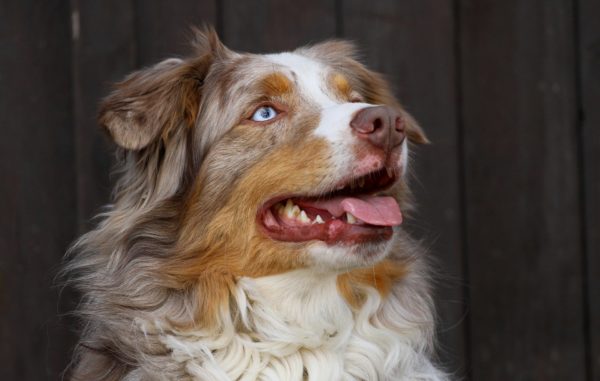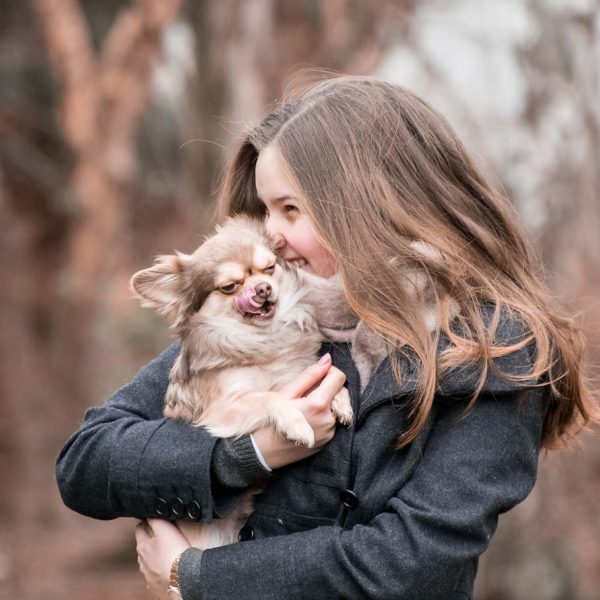
Oxytocin is the so-called “love hormone”. It is responsible for helping us feel bonded with each other and promotes trust. It floods the systems of new mothers when they hold their freshly born babies. When couples physically show love to one another, oxytocin courses through both bodies. The bonding and fuzzy feelings promoted by oxytocin aren’t limited to interactions between humans. Turns out, your love hormone is released when you look into your dog’s eyes, too.

Oxytocin and the Positive Feedback Loop
Oxytocin is a powerful hormone that plays vital roles in sex, childbirth, and breastfeeding. In fact, it is sometimes used medicinally to move labor along when things slow or stall out. Researchers have conducted a multitude of studies on oxytocin in humans because it plays such a big role in female reproduction. Studies have also revealed the hormone impacts relationships, both socially and on an intimate level.
Let’s take a look at a couple of examples. Studies show that oxytocin makes us feel more relaxed, extroverted, generous, and cooperative in a group setting. It helps us go with the flow, so to speak. If you go to a movie with a group of friends, it is oxytocin that allows you to say yes to the rom-com when you really wanted to see the thriller. Other studies on the hormone have looked at intimate connections.
Humans who are in a new romantic relationship have higher levels of oxytocin in their systems than those who are single. This finding is one of the reasons oxytocin is sometimes called the “cuddle hormone”. Further, oxytocin release during interactions between humans kicks off a positive feedback loop. It goes something like this:
You look into your baby’s beautiful eyes and your body responds by opening up the oxytocin flood gates. In turn, your baby’s body gets her own rush of oxytocin. This triggers your body to release even more oxytocin. Then your baby does too! It goes on in this positive feedback loop, leaving both mother and child elated and filled with feelings of total devotion and love. It’s the ultimate natural high. What scientists wanted to know is, does that same loop happen when dogs and humans gaze lovingly into each other’s eyes?

Scientists Were Curious. Does Oxytocin Have a Cross-Species Effect?
Miho Nagasawa and Takefumi Kikusui are biologists from Azuba University in Japan. They wanted to find out if the same oxytocin positive feedback loop would occur when dogs and their people engaged in bonding behaviors. They set up an experiment to test it out. The researchers put dog-and-human pairs in a room together for 30 minute “play sessions.” Scientists observed the dogs and humans doing what they do best: petting, playing, and gazing at each other with affection. Oxytocin levels in the dogs and humans were measured after the 30-minute love fest.
The team discovered time spent gazing into each other’s eyes had the greatest impact on oxytocin levels. The researched placed pairs into two groups: those that locked eyes for a long time of 2.5 minutes or more and those that gazed for a short time of 45 seconds or less. Oxytocin levels increased by more than 20% in pairs that held a long gaze. The more you stare, the more you care? It seems there is some truth to that.

Females of Both Species Experience More Intense Chemical Connection
The team conducted a different kind of experiment to further explore the oxytocin connection. The team looked at things backward this time. The scientists gave each dog a boost of oxytocin with a nose spray mist. The dogs were placed in play sessions again. Playrooms held a mix of strangers and the dog’s own human. Without fail, dogs with boosted oxytocin levels did two things. They only had eyes for their own human. They stared into their human’s eyes at great length.
An interesting phenomenon presented itself during this part of the study. Female dogs were more intensely impacted by the boost of oxytocin than male dogs. They spent more time looking at their human female companions. They completely ignored the strangers in the room. What about the female humans receiving all of this doting attention? Their love hormone levels rose in response! Prior research has similar outcomes. Female humans are more sensitive to the hormone than males. It is unclear why this is the case but has been noted time and again in studies.

Dogs and Humans Have Co-Evolved Gaze-Mediated Bonding
This study produced one more fascinating revelation. The researchers ran the same scenarios as before. This time they used wolves instead of humans. Why would someone enter into a “play session” with a wolf? Don’t worry. These wolf and human pairs were already bonded. The researchers found human handlers who had raised wolf pups and had continued to care for them into adulthood.
Just like before, the wolves went into a room with their human handlers for a 30-minute play session. Oxytocin levels were measured. Eye gazing behaviors were observed. Wolves were given oxytocin boosts. Did the wolves voluntarily gaze into their handler’s eyes? Nope. Love hormone levels did not rise in the wolves. This response led the researchers to a ground-breaking conclusion. The oxytocin gaze feedback loop may have co-evolved between humans and dogs!
The study says, “These findings support the existence of an interspecies oxytocin-mediated positive loop facilitated and modulated by gazing, which may have supported the coevolution of human-dog bonding by engaging common modes of communicating social attachment.” In other words, dogs helped themselves wiggle their butts into our hearts and homes by gazing lovingly into our eyes.

Dogs Also Use Oxytocin to Read Social Cues
Let’s look at social cues. Social cues are hints that help us participate in conversation and other social interactions. They can be verbal or nonverbal. Social cues are what we follow when we realize we’ve taken too much of someone’s time and need to end a discussion. Social cues help us behave in an acceptable manner when we wait in line at the airport. Dogs respond to social cues, too. It is a skill that allows them to get along so well with humans.
One study showed that oxytocin allowed dogs to read human social cues more accurately. Dogs were placed into two groups. Group one was given an injection of the love hormone. Group two was given an injection of saline. The researchers hid food treats and provided social cues to help the dogs find them. For example, the human pointed to where the treat was hidden. In other cases, the human looked at the hidden treat. The dogs who had received a dose of oxytocin followed the social cues to find the treats more often than the control group.
There is a very real reason why you look at your dogs as your actual kids. You love them in the same way. Chemical reactions fire off when you gaze into your dog’s eyes or stroke her fur. They are the exact same chemical reactions that occur when you bond with your human child. We don’t need science to tell us that what we feel deep inside ourselves. Dogs and humans share an unbreakable emotional bond. The chemistry between mankind and our best friend is undeniable. Still, it’s validating to see scientific research that backs it up!
Sources:
https://science.sciencemag.org/content/348/6232/333
https://www.sciencedirect.com/science/article/pii/S1550413107000691
https://www.psychologytoday.com/us/basics/oxytocin
https://www.ncbi.nlm.nih.gov/pubmed/25647172
The post Study: Gazing Into Your Dog’s Eyes Releases Your Love Hormone appeared first on iHeartDogs.com.
via Whisker Therapy